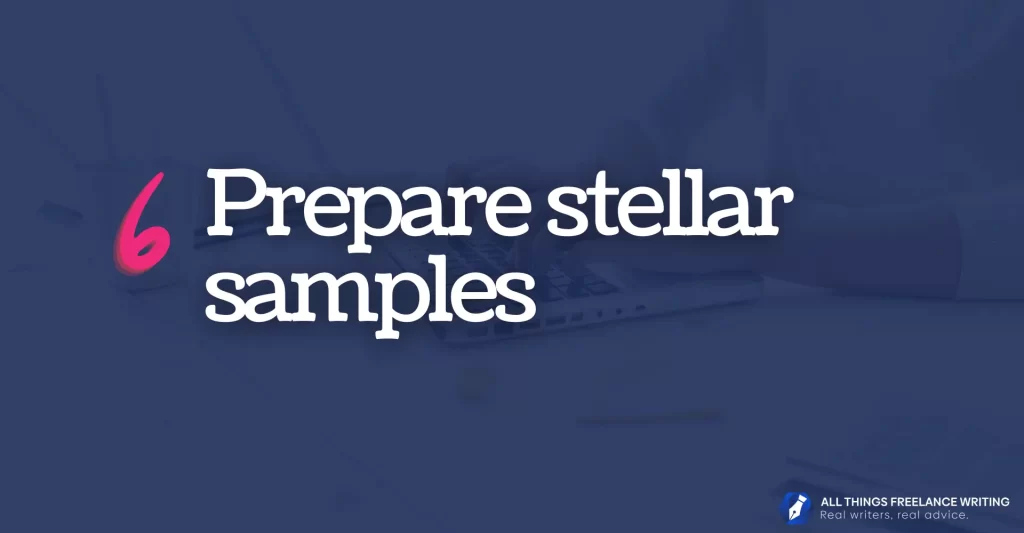Are you wondering how to start freelance writing? You’ve come to the right place!
As a freelance writer of 11 years, I can confirm — it can be a lucrative career that lets you live a comfortable life with a lot of freedom. But, it’s not typically a get-rich-quick kind of thing. More often, it will require some serious effort, time, and persistence.
So what’s all involved and how do you get started? Here are the 12 steps I recommend.
Table of Contents
- Decide what you want to write
- Identify your target client
- Set up your business
- Set your rates
- Plan your brand strategy
- Prepare stellar samples
- Get freelance writing clients
- Onboard new clients
- Deliver
- Collect testimonials
- Manage your workload
- Continuously optimize
Freelance writing definition
A freelance writer is a person who is hired to write something on a contract basis. They are self-employed business owners who provide writing services to clients. As a freelance writer, you determine how you work, when you work, and how much you get paid (at least you’re supposed to).
As for what you write, it can technically be anything; speeches, letters, grant proposals, books, resumes, and the list goes on. However, today, there’s a huge demand for freelance writers who write articles for online publications and content or copy for businesses (more on these below).
How to start freelance writing in 12 steps
Freelance writing can be awesome, but where do you start? Here are the 12 steps I recommend.
I’ve also included affiliate links to some of the products/services I recommend.
1. Decide what you want to write

A good first step is to research the different types of things you can get paid to write. The more in-demand a type of writing is, the easier it’s going to be to make money writing it. So, here are some of the most in-demand types of writing in 2023.
Copy and content
Digital marketing has gained steam in recent years (especially since the pandemic), so most businesses are trying to reach their target audiences online. They do so through websites, blogs, emails, social media posts, ebooks, ads, and more. All of the above require writing, and not just any writing — quality writing that speaks to the audience in the right voice, at the right time, with the right message.
Copy and content require quality writing that speaks to the audience in the right voice, at the right time, with the right message.
Every channel, and even the platforms within channels, have different requirements for writers. For example, the best practices for writing emails are very different than those for writing SEO blogs or social posts. Further, the way you write on LinkedIn will be different than how you write for Reddit, Facebook, or Instagram.
There’s a lot more to writing than meets the eye—and businesses are willing to pay good money for knowledgeable and skilled pros.
Stories for publications
Next, many online publications like The Huffington Post, Buzzfeed, and Scary Mommy are looking for a constant stream of stories (aka articles). They all want the next big headline that’s going to entice their audience to stop and click. Hundreds, if not thousands, of online publishers exist, and many of them are paying freelance writers for stories.
Which is best for you?
I encourage you to explore different types of writing to see what interests you. Some writers start out as generalists who offer anything and everything. I did and remember clients would ask me to write things and I’d have to Google what they were…like “what is a whitepaper” or “what is an SEO blog post?”
Starting out as a generalist lets you try out different things which can help you see what you like and what’s most profitable. You’ll also have a much broader audience to target. However, it can make it harder to get jobs as you’ll often be competing against specialists.
A lesson I learned later than I would’ve preferred is that becoming an expert in a writing type for a specific industry (aka niching down) can help you attract more clients, command higher rates, and receive fewer objections. That said, all niches aren’t equal so it’s important to gauge the market (more on that below) before going narrow.
Want to learn more about a particular type of writing? Check out the guides below:
2. Identify your target client

The next step is to decide who you want to write for — who will your ideal client be? Will they work in a certain industry such as healthcare, the outdoors, tech, or pet care? Additionally, what type of organization will it be? For example, will you target solopreneurs, small businesses, medium-sized businesses, enterprises, publishing companies, or Fortune 500s?
If you’re thinking, I have no idea…here are a few things to consider.
What’s your background?
Do you have experience in a certain industry? Your background knowledge and experience could be an asset to you as a freelance writer. For example, if you have a background in marketing, you may be able to write about marketing for marketing agencies. If you have a background in teaching, perhaps you could write about education.
Bringing expertise to the table can help you get a jumpstart as a freelance writer. It gives clients an extra reason to choose you and can help to warrant higher rates.
What industries are growing?
Another factor to consider is the growth trends of industries. When an industry is growing, the businesses within it are more likely to be growing. This has a trickle-down effect that impacts the financial health of businesses and what they are able to invest in marketing. So, it’s wise to investigate which industries are currently doing well and trending up.
SmartBlogger recently released an article on the best writing niches for 2023 and named the following as the most profitable:
- Finance
- Crypto/blockchain
- Tech writing
- Digital marketing
- Software-as-a-service (SaaS)
- Alternative health
- Education
- Real estate
I’ve seen writers thriving in all of these niches recently but especially finance, SaaS, crypto, and digital marketing.
What do you want to write about?
Another important factor to consider is what you enjoy. If you don’t like what you’re writing about, you’re going to be pretty miserable which isn’t good for you or your clients. So along with the above two factors, I’d recommend thinking or experimenting a bit to find out what you enjoy.
Warning: It may not be what you think! I thought I’d like to write about travel and ended up enjoying personal and business finance more. Never would’ve guessed!
What type of businesses do you want to write for?
The type of business you decide to write for is going to determine who you’re working with and what that process is like. For example, if you’re writing for:
- Solopreneurs, like coaches or consultants, you’ll likely work directly with them.
- Startups, you’ll likely be on a tight-knit team with the founder, developers, designers, and more.
- Established businesses, you’ll likely work with a representative from the marketing department like a content editor or marketing manager.
- Publications, you’ll typically be pitching to editors.
In most cases, larger companies will have more systems and processes in place. This can mean more predictability but less freedom in your work and operations. When prospecting, it can also be a bit more difficult to find the right person who hires writers at larger operations.
On the other hand, when businesses are less established, there is often more flexibility and freedom, but sometimes the systems can be lacking which can result in slower payments, less-detailed briefs, missing style guides, etc. All have their pros and cons.
Still not sure who you want to write for? That’s okay
Now, if you’ve asked yourself all of these questions but still aren’t sure who you want to write for, or even what you want to write, that’s okay. It can be a lot when you’re fresh on the scene. What you can do to gain a better understanding is target digital marketing agencies.
Why?
Digital marketing agencies typically help clients grow through strategies that involve lots of content and copy. As a result, they have an ongoing demand for writing and often turn to freelancers.
If you can get hired by an agency or two, it’s a great way to get familiar with freelance writing overall. The agency goes through the trouble of getting the clients, onboarding them, and prepping the strategy. You can then get assigned different types of writing assignments for different clients in various industries.
I went this route and it helped me to understand my options, gain experience, and figure out what I liked to write best. You also get a behind-the-scenes look at how an experienced individual runs writing projects and manages clients.
3. Set up your business

Okay, if you’ve made it this far and still want to be a freelance writer, it’s time to set up your business. There are a few routes you can take on this front. Here’s a quick rundown of the popular options in the U.S.
Sole proprietorship
If you don’t set up any business structure, your business will be a sole proprietorship by default. As a sole proprietor, you are your business and your business is you — there is no separation. While easy when it comes to the set-up because you don’t have to do anything, the downside is that you’ll be personally liable for any lawsuits brought against your business and any business debts. It also lacks some of the tax advantages you can get with other structures.
Limited liability corporation (LLC)
An LLC is a business structure that separates you from your business, offering protection from debts and liabilities. To set it up, you’ll need to file Articles of Incorporation with your state. You’ll have to research the laws in your state for details. Typically, the profits and losses are passed down to the owners to report on their personal tax returns. However, you can also opt to set it up as a corporation.
S Corp
An S Corp is a type of corporation that passes down the profits and losses to its shareholders. You can set this up to gain protection from liabilities and debts, and some tax benefits (some of your profits can be distributions). To do so, you’ll go through your chosen state’s process. However, it can be an involved process with various fees.
My take? I think it can make sense to start out as a sole proprietor (possibly with business insurance) when testing the waters and getting established. Then, it can be helpful to set up an LLC or establish an S-Corp once you’ve found your footing and are earning more than the average salary for a freelance writer. But it’s best to consult a tax advisor and do your research before making a decision.
If you live outside the U.S., refer to your government’s website to review your options.
EIN
While an Employer Identification Number (EIN) is not required if you don’t have employees and don’t file any pension plan or excise tax, you can get one if you’d like to use your EIN (instead of your social security number) for business accounts or to build credit.
Business insurance
Business insurance can help to protect you against potential claims. For example, if you write something and are sued for some reason, it could help to cover the costs. While not a bad idea for any writer, it becomes more important as your content is reaching larger audiences. Thimble provides some flexible plans that are great for freelancers!
Business bank account
Next, open up a business bank account. Doing so will enable you to keep your business and personal finances separate. If you are happy with your existing bank, you can contact it about a business account. Alternatively, if you want an online account that is convenient, affordable, global, and freelancer-friendly, I highly recommend Wise.
Payment processing service
You’ll also need to decide how you are going to accept payments. The main options are:
- Payment processing company (PayPal, Payoneer, etc.)
- ACH/direct deposit to bank (often the cheapest route)
- Physical check (slow and outdated)
- Credit card payments (PayPal, Stripe, Square)
- Invoicing software (Wave, Bonsai, FreshBooks, HoneyBook)
I’d recommend considering the fees, processing time, and user experience of a payment solution to find the best fit.
Invoices
As a freelance writer, you’ll often need to create invoices and send them to your clients. You can do so manually with an invoice template, through a payment processing service, or via a business management software program.
I use PayPal’s free invoicing tool. If you don’t want clients to pay through PayPal, you can save the invoice as a PDF and send it via email. However, I’ve heard and seen writers use programs like Wave and Bonsai, and love them.
Project management
As you begin to get projects, it becomes very important to keep track of them all. You’ll need a way to document projects, who they are for, when they are due, how much you’re getting paid, and more.
Many project management software programs exist that can help such as Asana, Monday, Trello, and ClickUp. While these programs can be very convenient, they often do come at a cost. If you’re on a tight budget, Google Sheets can also work well.
Business email address
In many cases, clients will want to communicate with you via email. If possible, I recommend that you purchase an on-brand domain name for your writing business and set up an email with that domain.
For example, my domain is jessicawalrack.com, so my email could be info@jessicawalrack.com.
I have purchased domains and set up email accounts through both GoDaddy and Bluehost.
If you’re not ready to purchase a domain yet, you can use a free email address through Gmail or another provider. I did this for many years and never had any negative reactions to it (that I know of). But an email addy with an owned domain is typically a small investment that can help to make a positive impression so I’d recommend it.
Writing contracts
Next up, writing contracts. Writing contracts outline the terms and conditions of your writing service. In many cases, clients provide their own contracts to protect their interests. They often include clauses for non-disclosure, the transfer of intellectual property, non-employment, the release of liability, payments, termination, and more.
Warning: Watch out for non-compete clauses! I do not recommend agreeing to these as a freelancer, and most won’t ask you to.
Even if a client provides a contract, I recommend you provide one, too. It can help to establish your boundaries, protect your interests, and set clear expectations. Consider adding clauses regarding payment terms, payment due dates, late fees, communication deadlines, revision terms, project deadlines, project scope, and the costs for requests beyond the scope.
Why is it important? Things go wrong sometimes. For example, a client may pay you a retainer for a month’s worth of work, but then not assign you enough work. Do you refund the unused balance? Is it use it or lose it? These details should be outlined in writing and agreed upon.
Not sure where to start? If you want to DIY, I like this Freelance Contract Template from Pandadoc. If you’d like professional legal advice, LegalZoom can be an affordable way to get it online.
4. Set your rates

Alright, time for some money matters. Of course, the reason you’re getting into freelance writing is to make that money honey! Sure, you may have other goals, but money is important. So the big question is — how much should you charge?
There are typically three approaches to writing rates:
- Hourly: You get paid based on the hours it takes you to finish projects (common in editing projects).
- Pay per word: You get paid based on the number of words you write (common in blog and article writing).
- Fixed rate: You give clients a fixed price for a defined project (most common for copy and content writing projects).
As the business owner, you get to decide when, what, and how to charge. It can be helpful to research the average rates in the market for different types of writing, and certain factors that allow some writers to charge more (e.g. case studies, big bylines, weighty endorsements, strong branding, etc.).
If you come out of the gate charging top dollar and don’t have anything to prove your work is going to be worth it, you can hit a brick wall (aka lots of nos). On the flip side, you don’t want to undercharge and suffer unnecessarily. It’s important to understand common rate ranges, what builds a writer’s value in the eyes of clients, and where you stand.
Wondering what rates are common in the industry? Check out the results from our 2023 survey of 346 freelance writers!
You can also find more solid pricing advice through the following links:
- The American Writer’s and Arts Institute’s (AWAI) Pricing Guide
- The American Writer’s and Arts Institute’s (AWAI), State of the Industry Report on Copywriter Rates and Top Performing Marketing Methods.
- Upwork’s guide to writing rates.
5. Plan your brand strategy

Next, consider how you want your writing business to be perceived in the market. What makes you stand out? Who are you talking to and what’s your brand voice? What are your values and how do you operate?
By taking time to define who you are as a service provider, you can build a strong foundation that enables a cohesive presence both on and offline.
You can work through the process yourself with tools like this ebook (How To Win Over Readers, Clients And Customers: A Guide To Personal Branding For Bloggers And Solopreneurs), or you can hire a brand strategist to help you.
6. Prepare stellar samples

The good news about being a freelance writer is that you don’t need a ton of experience, a degree, or an impressive resume. So, what’s the catch? You need reallllly good samples. Every client I’ve ever had has asked to see my samples. Solid samples will close a deal, while weak ones will cause you to lose it (sorry, but it’s true).
So how do you make sure your samples are helping not hurting you?
First, samples work best if they demonstrate the type of work that a client is requesting. So, think about what you want to create for clients and select a sample accordingly. Additionally, it’s important that your sample is the best possible representation of your abilities.
You want to ensure the writing is squeaky clean and that the piece achieves the goal of the particular writing type. For example, if it’s a blog post, it should follow SEO best practices (even better if it ranks well for the primary keyword). If it’s a story for a publication, it’s best if it has an intriguing headline, an interesting story, and a good amount of views/engagements.
Tip: If you don’t have any samples yet, you don’t have to wait for your first job or agree to unpaid writing tests. Blogs or articles can be self-published on your blog, on Medium, or on LinkedIn Articles. You can test out your social media copy or content writing on your own accounts. Other types of content or copy can be created via Google docs, Canva, Figma, etc., and downloaded as PDFs.
7. Get freelance writing clients

Now, you’re ready to get freelance writing clients. So, how do you do that? There are two main approaches; going out and finding clients (outbound) and creating a presence so they come to you (inbound).
Outbound marketing
When first getting started, outbound is often necessary. You have to put in some work to get the ball rolling. The most tried-and-tested way to land clients is through what’s known as cold pitching.
Cold pitching refers to finding people who may be interested in your services and sending them a message offering your solution. It’s called “cold” because it refers to reaching out to someone you don’t know.
Pitch publications
If you want to pitch publications, you’ll research sites, find the contact details for editors, and send them pitch ideas. For example, say you’ve decided you want to write about pop culture on Buzzfeed. You could head over to BuzzFeed and peruse the articles to get inspiration. Jot down your ideas. Then, poke around looking for editor contact info.
Tip: Amber Petty has a very helpful list of over 250+ publications that accept pitches (complete with rates and editor contact info)!
The more traffic and domain authority a publication has, the more it usually pays. You can check the stats on up to 10 sites per month for free using SEMrush‘s free plan. That link will also give you an extended 14-day free trial of the platform in case you’re interested in all it can do.
Pitch businesses
If you want to target businesses, research those that could be a good fit and reach out to the person who you’d guess is in charge of the content and copy. In smaller companies, it may be the founder or CMO. In larger companies, it may be a content editor, creative director, or director of demand generation. You can research who to contact on company websites, LinkedIn, and Twitter. In time, you’ll learn who typically handles hiring writers.
Once you have the info, what should your email say? I don’t recommend the “spray and pray” technique. I believe in treating people how you want to be treated. If you’re going to send someone an email, do your homework. Look for an opportunity to help them. Then, send a thoughtful email personalized to them.
If you’re not sure where to start, listen to episode 5 of the ATFW podcast with Maya Capasso. She shares her warm fuzzy approach to cold pitching and an actual pitch that landed her a deal.
Pitch outline
To sum up her approach, she formats her pitch as follows:
?Discuss the client’s current needs
?Give authentic compliments
?Address their pain points in detail
?Provide a tailored solution
?Show proof of your ability to deliver (with links)
?Position the benefits creatively
?End with a call to action (CTA)
In addition to pitching via email, you can join work platforms like Upwork and Problogger and apply for jobs. This route can be easier in that the whole framework is there for you. Clients are ready to hire and the platforms provide escrow, contracts, security, etc. The downside is there’s a lot of competition, it can be hard to break in, and there are various fees.
You can also look for opportunities on job boards (check ours out!), through job email lists, and in FB writer groups. Here’s a look at 28+ legit places to find writing jobs
Inbound marketing
Inbound refers to a marketing approach where you build a presence online to attract your ideal clients to you. This route requires planning messaging that raises awareness of your writing services and moves your ideal clients through the buyer’s journey.
Once the inbound engine is going, it’s honestly fabulous. If you’re doing it right — people will know you, trust you, and reach out excited to work with you. However, it does take strategy, experimentation, putting yourself out there, and consistency.
Where are good places for writers to build a presence in 2023?
- Your website and blog
- LinkedIn (Find profile and engagement tips)
- TikTok
- A podcast
- Medium
- Freelance writer directories
I recommend a mix of outbound and inbound in the beginning, with the goal of 100% inbound.
8. Onboard new clients

Once you’ve landed your first client, it’s time to bring them on board. Here’s a quick checklist:
- Meet new clients on a 15-min Zoom call (highly recommend to build rapport)
- Collect all the information you need for the project (get the assignment brief)
- Agree on a price
- Discuss allowed revisions
- Set a due date
- Set review deadlines
- Share business hours/response timelines
- Agree on how the piece will be delivered (e.g. Google doc or word doc via email, written in publishing platform, etc.)
- Get all of the above in a contract
- Have both parties sign the contract
- Get at least 50% upfront (highly recommended)
- Get to work!
Once the deal is all set and you have what you need — schedule the project so that you have enough time to finish it by or before the deadline.
Tip: I recommend setting your personal deadline 1-2 days before the client’s deadline. Also, be sure to review the brief right away so you can ask any questions upfront. You don’t want to get to your writing day and find out you need something else.
9. Deliver

Once you’ve written the piece, proofread it (Grammarly and HemingwayApp can help), run it through a plagiarism checker like Copyscape, and ensure all of your client’s requirements are met. Then, it’s time to deliver! Be sure to send the piece by or before your client’s deadline and ensure they are notified it’s been sent.
I also recommend that you communicate anything that may be helpful for the client. For example, if you added a section not included in the brief, add a note and explain why you made that decision. If you recommend a link or graphic, let them know.
Further, subtly remind the client that it’s the first draft, you are open to any and all feedback, and you are looking forward to their response. You don’t want them feeling like they’re walking on eggshells or can’t be open about the changes they need.
Speaking of — sometimes feedback can burn. If you take offense to any feedback, I highly recommend stepping away before you respond. Giving writing feedback is an art and many business owners aren’t well-versed in it.
You always want to remain professional and give them the benefit of the doubt. And, if any requests are out of scope, ensure you explain that you’re happy to make the changes but they will come with an additional charge. Revert back to the brief and contract for reference when needed. If it’s not on the brief, it’s extra! It’s all business, not personal.
Learn the 10 must-have freelance writing skills that have nothing to do with writing.
10. Collect testimonials

When you finish a project and your client is happy, that’s the perfect time to ask for a testimonial! You want to capture that positive emotion and satisfaction.
If you’re on LinkedIn, I recommend requesting it through the platform’s recommendation function. It’s harder to fake those reviews which can make them more credible to future clients. You can then copy them from LinkedIn and publish them in other places like your website if you’d like.
If you don’t have a LinkedIn yet, you can ask for the testimonial via email or however you communicate with clients.
But how do you ask? You can say something like, “I’m so glad you are happy with the project! When you have a chance, would you mind writing a quick review to share your experience with my service? I’d greatly appreciate it.”
I’ve also heard some writers say they provide specific questions to guide clients. If you want to go that route, Hubspot offers some good testimonial question ideas.
11. Manage your workload

As you begin to get more clients, it’s easy to get overwhelmed. To ensure you don’t overbook, I recommend figuring out how many days and how many hours per day you are willing to work. Then, you can schedule projects and will be able to see how much space you have left.
Tip: Track your work time so you have an accurate idea of how long each assignment takes you.
It’s incredibly important to draw boundaries and keep them. It can be tempting to work all the weekends and late nights to earn more, more, more. But you will burn out eventually. To be at our creative best, I believe humans need rest and downtime. To achieve that, you’ll need to intentionally plan for it. You won’t have a boss forcing you to take breaks!
Diversifying risk
Another important thing to keep in mind? You need to diversify your risk. Running your own business means all your income rides on your clients. If you only have one or two clients, you’ll be walking on thin ice. Further, if you only have leads coming from one or two places, again — you’re at risk.
When I started, I was solely on Elance (which is now Upwork). I had a lot of work coming in and all was just peachy. Then, Elance announced it was acquired by Upwork. Clients left Elance, but Upwork wasn’t up and running yet. I was left high and dry, scrambling for new ways to find clients. My biz barely survived. To protect against a lost lead channel sinking your ship, I recommend you have work coming from at least 4-5 different channels. (I think the risk is higher today due to social platforms being more quick to suspend or cancel accounts.)
Similarly, a few years later, I landed a client who paid really well and had lots of work for me. I was excited and let them account for about 80% of my workload. Unfortunately, they soon began scope creeping, cutting rates, and paying late. All of these are horrible for the health, happiness, and bank account of a freelance writer, but I was pretty stuck.
From that experience, I learned not to let any client consume more than 20% of my time. Then, you’re okay if one bails, pays late, or needs to be cut.
12. Continuously optimize

Lastly, at the end of the month, review all your projects. Assess which were the most profitable, which were the most enjoyable, which were a pain, which weren’t worth it, etc. Use that information to fine-tune the definition of your ideal client and your service offerings.
If something took up too much time or caused a bottleneck, take note and consider new how you can prevent it. As you continue to move toward what’s most enjoyable and profitable, you’ll be on the path to your ideal business!
Frequently asked questions about starting a freelance writing business
Still have questions? Check out these FAQs about starting a freelance writing biz.
How do I start freelance writing with no experience?
Starting a freelance writing business with no experience is possible as long as you can write. A good first step is to research various writing types and niches to decide what you want to write. Then, create samples you can show potential clients. You can publish articles on Medium, LinkedIn, or your own blog. Or, for copywriting, you can create mockups in Canva, Figma, or another program.
Is it hard to get into freelance writing?
Becoming a freelance writer has its challenges but it has a lower barrier to entry than many other businesses. You will need a laptop, internet access, writing skills, and research skills. Further, as with any business, it’ll require branding, marketing, sales, accounting, and admin. You can learn a ton about the lay of the land by reading books on writing from reputable writers who have gone before you.
Can I use AI in my writing?
It depends on your client. Some may forbid the use of AI tools, some may encourage them, and some may not care. However, generally, clients hire human writers for human writing. If AI is used, most don’t want it detectable in the end product, and they may use AI writing detectors to test your work.
Do I need an LLC for freelance writing?
You don’t need an LLC but it can help to reduce your personal responsibility for business debts and liabilities.
How do freelance writers get paid?
Every freelancer is a business owner who can decide how they get paid. Freelancers can get paid upfront, post-project, or a mix. Additionally, they may get paid by the word, hourly, or on a fixed rate basis.
What exactly does a freelance writer do?
Freelance writers are hired on a contract basis to write materials for their clients. The written materials can take many forms from books and articles to case studies, social media posts, letters, speeches, and much more.
Disclaimer: I’d like to point out that there’s not really one official way to build a freelance writing business. I’ve had the pleasure of meeting many writers and every single one of them has tread a unique path. However, there are some common threads; I covered them here.
Sign up to get the latest ATFW blogs, resources, and news delivered to your inbox!



Thank you Jessica. This is of great help to all of us out there who feel their business hasn’t quite launched yet.
Keep up the magnificent work.
Thanks so much, Flor! I’m so glad to hear you found it helpful and there’s lots more to come!